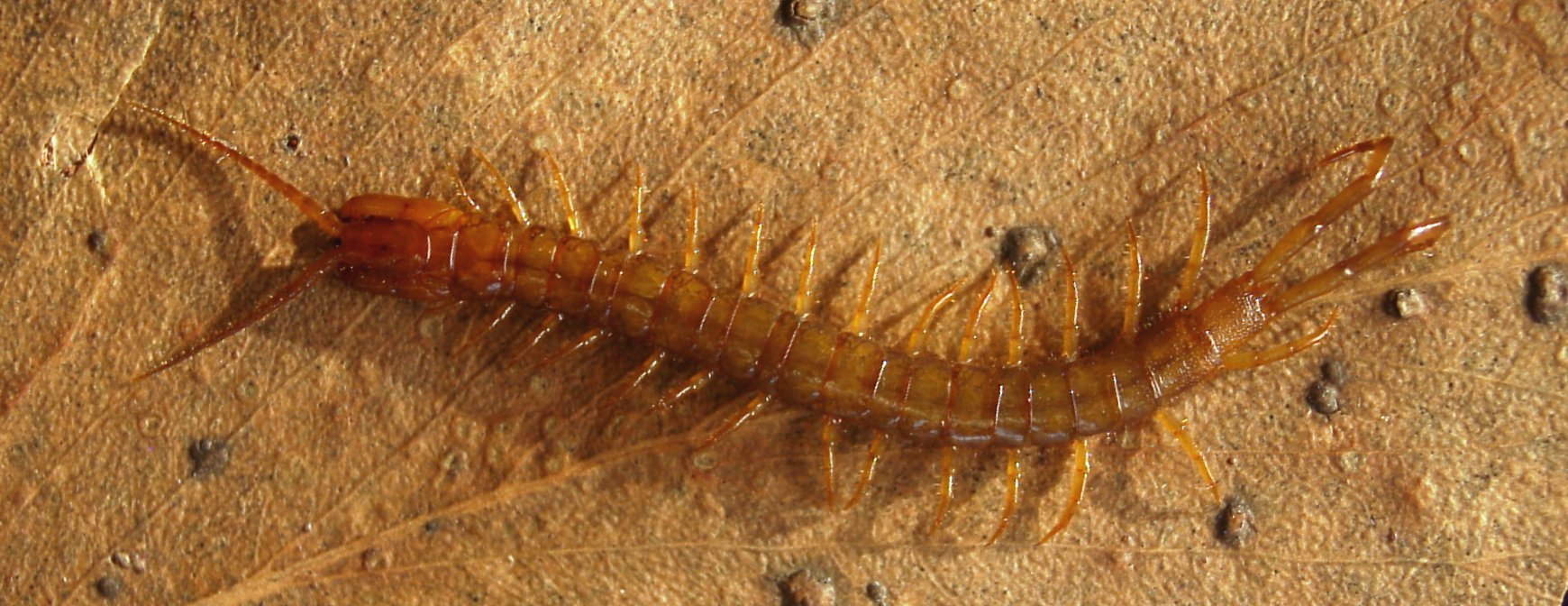Key to Australian Freshwater and Terrestrial Invertebrates
Phylum Arthropoda
Subphylum Myriapoda
Class Chilopoda
Order Craterostigmomorpha
Common name: craterostigmomorphs
Overview
Craterostigmomorphs have 15 pairs of legs and sterna, with a long apical spine present on the trochanter of the 14th and 15th pairs of legs. The long tergal plates are subdivided in two and there appear to be 21 tergites. The length of head and body grow up to 50 mm and are usually greenish brown in colour with a red-brown head. The head capsule is longer than wide and the antennae are tapering with 17�18 articles. There is one ocellus on each side of head shield, and the maxillipedes or �poison claws� project in front of the head shield and are clearly visible in dorsal view. The anal organs are enclosed in an elongate, ventrally opening capsule with a mesh of openings for the coxal organs. It is thought that the main functions of the anal organs are the absorption of atmospheric water and the release of pheromones. Maternal brooding unites Craterostigomomorpha with the Epimorphs into the clade Phylactometria. This trait is thought to be closely linked with the presence of sternal pores, which secrete sticky or noxious secretions, which mainly serve to repel predators and parasites.
Distribution and diversity
The Craterostigmomorpha is the most geographically restricted and least-diverse order. It occurs only in Tasmania and New Zealand and presents an exclusively trans-Tasman distribution, a pattern best explained by either a relictual east Gondwanan distribution or by a more recent trans-Tasman dispersal event. The order comprises only one family, one genus, and two described species, Craterostigmus tasmanianus from Tasmania and Craterostigmus crabilli from New Zealand.
Life cycle
Fertilization in craterostigmomorphs is external, males deposit a spermatophore which the female transfers to her genital atrium. Craterostigmus tasmanianus females brood eggs and young between September and April and have clutch sizes of 44-77 eggs. In Tasmania the breeding season lasts from November to February. Females lay egg capsules in clusters in small crevices excavated in the soil or in chambers of damp decaying logs. The female ceases feeding while brooding and coils her body around the egg cluster and the early hatchling instars. Grooming of the eggs while brooding seems to function in the removal of fungi. Craterostigmomorpha development is intermediate between the basal Anamorpha centipedes and the derived Epimorpha, with only one phase of anamorphis. Hatchlings emerge with 12 pairs of legs, and add the final three legs in a single moult. Sexes are difficult to distinguish without examining testes or ovaries.
Feeding
The natural prey of craterostigmomorphs is unknown, but potential prey include soft-bodied arthropods such as amphipods, isopods, millipedes, fly larvae, beetles, collembolans, mites and other centipedes. In captivity, craterostigmomorphs have been observed to use their poison claws to dig termites from crevices in wood, but this association with termite mounds has not been found in the wild.
Ecology
In Tasmania Craterostigmus tasmanianus is widely distributed in native forest and woodland including rainforest, wet and dry eucalypt forest, subalpine woodland, and riparian and swamp forest. It occurs from sea level to at least 1300 m, but has not been recorded from moorland, grassland or heath. In the drier portion of its range is restricted to permanently moist microhabitats including rotting logs, deep humus and wet leaf litter. In western Tasmania C. tasmanianus is common and tolerates considerable habitat disturbance. Craterostigmus tasmanianus may compete for prey with other species of centipedes and other invertebrate predators of similar size and cryptic habit.







